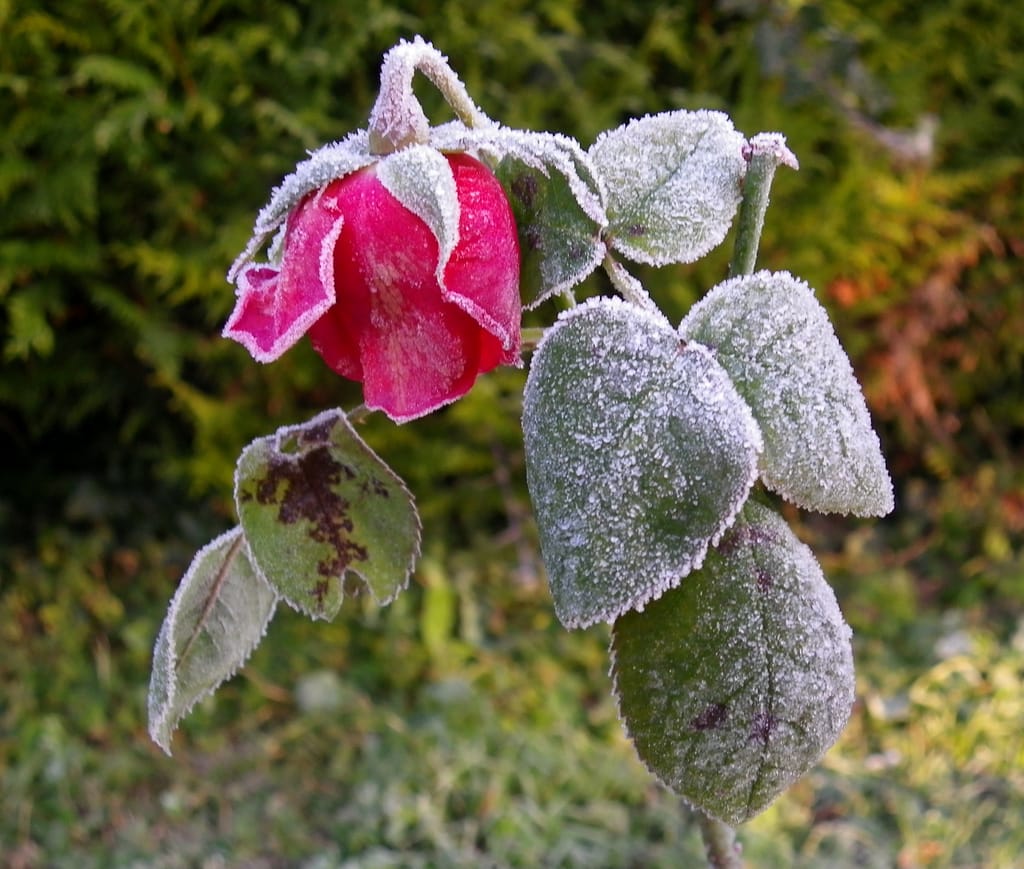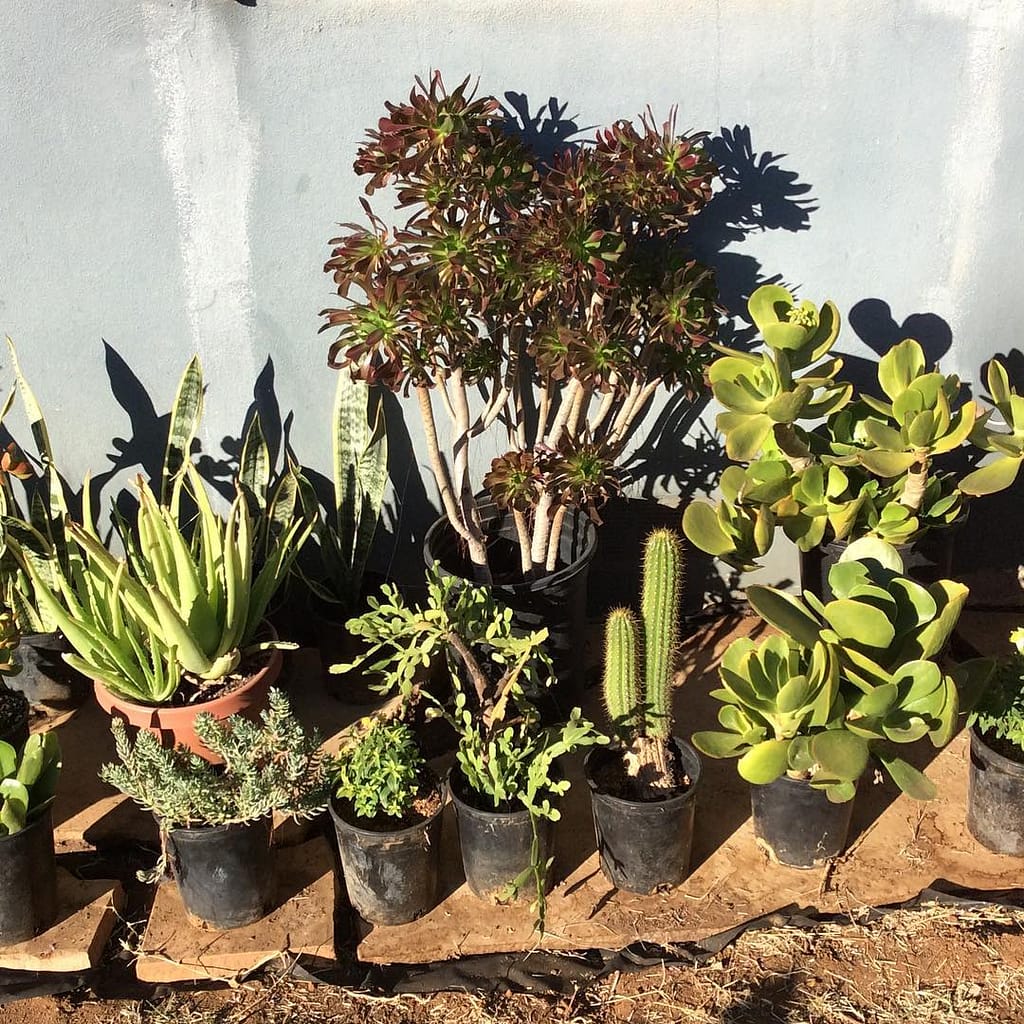
The cold season can be a foreign idea to desert dwellers. A lack of information about the cold seasons and how it affects your plants can lead to frustration while landscaping or gardening. You might think “It didn’t snow this year, why did my plants die?” Cold damage and a plant’s cold hardiness is much more nuanced that. Here you should find more than sufficient information to help you navigate the cold season. Before we get into all of the details, there are a few words that might not be familiar to you.
Cold Snap
A cold snap is when you get freezing temperatures in the fall at night before it is generally expected. This is usually before deciduous plants and trees have lost their leaves or have shown their fall color. That freeze damages the leaves before they finish their natural progression of color change.
Late Freeze
A late freeze is similar to a cold snap, but in the late spring. Once new growth has emerged, freezing temperatures can damage the vulnerable leaves. The tree or plant then has to push out a new set of leaves and is in a state of distress until it is able to regain vigor throughout the season.
Borderline Plant
A borderline plant is a plant that is planted in a location that is on the end of the plants hardiness tolerance. This is usually accompanied with a difficulty around the extremes of that zone. Purple Fountain Grass has a USDA hardiness rating of zones 8-11. Planting one in a USDA zone 11 location or a USDA zone 8 location would classify it as a borderline plant that can be susceptible to temperatures that are too hot or too cold. At zone 8 here in the high desert, Purple Fountain Grass struggles during the winter, and sometimes doesn’t make it.
Borderline Plants
Lantanas fall into this category for our local conditions. They are cold hardy to zone 8 and we are zones 8-9ish. They are known to die back down to the ground and sprout the following year. This happens when we have a mild winter, but is not always the case when a cold winter rolls around. There are ways to combat this, but they are a great example of a borderline plant.
More borderline plants for our local climate:
- Star Jasmine
- Many Salvias
- Purple Fountain Grass
- Lantana
- Mesquite, Eucalyptus (varies), African Sumac, and California Pepper, trees that are young and recently planted
Borderline plants tend to be the plants that die or are frequently damaged in the winter. You can avoid this by planting plants that are well within your hardiness zone, or by taking protective measures that can ensure that it will overwinter well.
Early Cold Snaps
These early cold snaps can make a plant that is not a borderline plant as sensitive as a borderline plant. Crape myrtles are an example of this in our local climate. The past few years a lot of local crape myrtles have died back significantly, and in some cases, back to the roots. These years we had an early cold snap, followed by a colder than normal winter.
What the cold snap does, is it damages or kills the leaves before the plant can reaccumulate energy by going into a state of dormancy. This then depletes that amount of “energy” the plant has to rebound in the spring. If the plant already was stressed by drought, pests, diseases, or improper care, then it might be the last straw.
Late Spring Freezes

Late spring freezes are similar to cold snaps, but in the late spring. Leaves from deciduous plants and trees emerge in spring. A mechanism of plants is to form a waxy cuticle on their leaves to protect the leaves from harsh environments. If a late freeze happens before those leaves have formed a cuticle, then they become damaged or dead. This then depletes the energy a tree has to push out another flush of growth. As with the cold snaps above, if the tree is healthy, it can sometimes handle an occasional freeze, but a stressed tree cannot.
Cold Hardiness and Branch Girth
Another common problem we run across in our local high desert climate is poorly timed pruning and fertilizing. Pruning, along with vigorous fertilizing, generally incurs a flush of growth, especially if done during late summer or early fall. These actions create thin, young shoots that lack cold tolerance. This is due to insufficient time to recover energy and thicken over the growing seasons.
As a branch increases in girth, the cold hardiness increases with it. This becomes a problem with planting smaller trees that are cold sensitive. As mentioned above, California pepper, mesquite, eucalyptus, crape myrtle, African sumac, various palm trees, and a few others suffer if they are exposed to harsher cold temperatures when they’re young. This can cause branch/trunk dieback, death, or damage to evergreen leaves.
Adult plants are hardier than juveniles and seedlings. However, the increase in frost hardiness is far less marked in the roots than in the shoots. The maximum frost hardiness of shoot cambium in Quercus ilex goes from −16°C during its first year to −25°C after 3 years, while for roots, the maximum frost hardiness goes from −6.5°C to −8°C during the same period (Sakai and Larcher 1987)
Valentin Ambroise, Sylvain Legay, Gea Guerriero, Jean-Francois Hausman, Ann Cuypers, Kjell Sergeant, The Roots of Plant Frost Hardiness and Tolerance, Plant and Cell Physiology, Volume 61, Issue 1, January 2020, Pages 3–20, https://doi.org/10.1093/pcp/pcz196
Roots vs Shoots
In the containerized environment, plants can be sensitive to cold temperatures in their root zone. On some cold hardy species, their roots can reach lethal temperatures starting at 28°F. As mentioned above, age doesn’t drastically increase the cold tolerance of a plant’s roots. There are two things that can help you loosely determine the ability of a plant to withstand cold temperatures, root girth and a species general root depth.
Plants that tend to have more shallow roots, such as maples, elms, willows, birch, cottonwood, beech, azalea, boxwood, hydrangeas, barberry, camelias, holly and several others, are typically exposed to colder temperatures due to their roots being closer to the surface. This means that their roots are capable of colder temperatures for the most part, but also that their roots are more fibrous and easily damaged once the threshold has been passed.
Plants with thick, or not very fibrous, roots are also more cold tolerant than fibrous roots. Some species, such as deciduous hydrangeas, have fibrous roots that are shallow and are still cold hardy. Sadly, there isn’t a fantastic database that shows which plants have thick roots, but you can use the eye test when planting, repotting, and maintaining your containerized plants.
Shoots, or branches, are almost always more cold tolerant than roots. The exact reasons isn’t full understood, but one reason may be the water content:
Several hypotheses have been proposed to explain the difference in frost hardiness between roots and shoots. The relative water content is up to three times higher in roots than in aboveground organs. This higher water content would be associated with reduced hardiness, presumably because it increases the risk of deleterious ice formation (Burke et al. 1976, Levitt 1980, Bigras et al. 1989, Pearce 1999).
The Roots of Plant Frost Hardiness and Tolerance, 2019, https://academic.oup.com/pcp/article/61/1/3/5593656
One last comment about root damage is that you won’t notice it until the spring. Deciduous plants will send out leaves like normal, but then as the leaves require water, there are no healthy roots to absorb and transport water and the plant wilts and dies.
How Can I Prevent Cold Damage To My Plants?
Keeping your plants in good health is key to preventing cold damage. One way of doing that is making sure to keep your plants watered, especially before the cold season really sets in. As mentioned above, not over fertilizing or pruning in late summer or early fall will keep tender branches that are susceptible to cold damage from forming.
Above Ground
Preventing cold damage from branches and twigs can mostly be done by planting plants that are hardy to your zone. However, there are many that want help preventing cold damage for plants outside of their zones. These methods are also useful to help protects your plants overnight when a cold snap or late freeze is coming.
You can wrap the plant with one of many things to insulate overnight (bubble wrap, blankets, frost cover, greenhouse plastic, cold frame, etc.) or you can move the plant, in the case of potted plants, to a location that is more protected and has heat retaining objects nearby.

You can see the succulents placed on top of stones which retain heat
Below Ground
Keeping plants near heat absorbing objects can ease the hour or two of the most cold temperatures during the night. Rocks, cinder blocks, walls, homes, concrete, pool areas, porches and other similar places retain heat and give it off during the night time. This includes placing any potted plants on the ground if they weren’t already there.
Mulching your plants (which I highly recommend in almost all cases) is a great way to avoid root damage from the cold. Mulching decreases wide temperature swings in the soil which eases the extreme temperatures throughout the year. The same can be said about potted plants, mulching around the pot will drastically increase the cold tolerance that it can handle.
Newly planted trees that are not backfilled and tamped down sufficiently can show cracks in the soil near the rootball. This is a surefire way to cause cold damage as it gives an unrestricted path to the roots.
Sources used in compiling this information:
